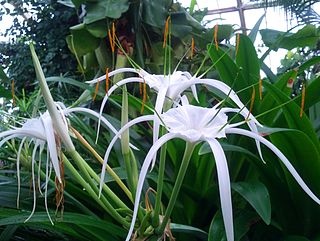
The Griffineae is a tribe in the family Amaryllidaceae, subfamily Amaryllidoideae. It includes 3 genera with 22 species endemic to Brazil in South America. A typical character of the representatives of the tribe are the flowers - They are blue or lilac and collected into an umbel. Only the members of this tribe and the genus Lycoris are able to form flowers with such color in the whole subfamily Amaryllidoideae of Amaryllidaceae. The species in this group are typically perennial and produce bulbs. The leaves are green, with elliptical form in most of the cases but in some members, as in Worsleya, they are sword-shaped.
Alan W. Meerow is an American botanist, born in New York City in 1952. He specializes in the taxonomy of the family Amaryllidaceae and the horticulture of palms and tropical ornamental plants. He also works on the population genetics and molecular systematics of cycads and palms.

The Amaryllidaceae are a family of herbaceous, mainly perennial and bulbous flowering plants in the monocot order Asparagales. The family takes its name from the genus Amaryllis and is commonly known as the amaryllis family. The leaves are usually linear, and the flowers are usually bisexual and symmetrical, arranged in umbels on the stem. The petals and sepals are undifferentiated as tepals, which may be fused at the base into a floral tube. Some also display a corona. Allyl sulfide compounds produce the characteristic odour of the onion subfamily (Allioideae).

Hippeastreae is a tribe of plants belonging to the subfamily Amaryllidoideae of the Amaryllis family (Amaryllidaceae). Species in this tribe are distributed in South America. Flowers are large and showy, zygomorphic, with the stamens in varying lengths, inflorescence bracts are often fused basally. The seeds are flattened, winged or D-shaped. Reported basic chromosome numbers are x= 8-13, 17, and higher. All the species in this tribe present a remarkable aesthetic interest and horticultural value.

Amaryllidoideae is a subfamily of monocot flowering plants in the family Amaryllidaceae, order Asparagales. The most recent APG classification, APG III, takes a broad view of the Amaryllidaceae, which then has three subfamilies, one of which is Amaryllidoideae, and the others are Allioideae and Agapanthoideae. The subfamily consists of about seventy genera, with over eight hundred species, and a worldwide distribution.
ZephyrantheaeSalisb. is a now obsolete tribe within the American clade of family Amaryllidaceae, containing five genera.

Narcisseae is a small tribe of plants belonging to the subfamily Amaryllidoideae of the Amaryllis family (Amaryllidaceae), where it forms part of the Eurasian clade, and is one of three tribes in the European (Mediterranean) clade. It contains two genera and approximately 58 species, but probably also Lapiedra. The two genera are distinguished from each other by the presence of a paraperigonium in the former.

Galantheae is a tribe of European, West Asian and North African flowering plants belonging to the subfamily Amaryllidoideae of the Amaryllis family (Amaryllidaceae). As of 2017, it contains three genera, although more were included previously. The position of the ovary is inferior.

Haemantheae are a tribe of subfamily Amaryllidoideae. They are herbaceous monocot perennial flowering plants with a predominantly African distribution. Three subtribes are proposed and six genera including the type genus, Haemanthus, are included. They are characterised by the presence of baccate (berry) fruit.

Calostemmateae are a very small tribe of subfamily Amaryllidoideae. They are herbaceous monocot perennial flowering plants endemic to Australasia. The tribe consists of two genera, Proiphys and Calostemma.

Pancratieae are a small European tribe of subfamily Amaryllidoideae, consisting of two genera including the type genus, Pancratium.

Traubiinae is a subtribe of plants classified under the tribe Hippeastreae. It belongs to the subfamily Amaryllidoideae of the Amaryllis family (Amaryllidaceae).

Eustephieae is a flowering plant tribe in the family Amaryllidaceae, subfamily Amaryllidoideae. It forms part of the Andean clade, one of two clades in The Americas.
Stenomesseae was a tribe, where it forms part of the Andean clade, one of two American clades. The tribe was originally described by Traub in his monograph on the Amaryllidaceae in 1963, as Stenomessae based on the type genus Stenomesson. In 1995 it was recognised that Eustephieae was a distinct group separate from the other Stenomesseae. Subsequently, the Müller-Doblies' (1996) divided tribe Eustephieae into two subtribes, Stenomessinae and Eustephiinae.

Eucharideae is a tribe of plants within the family Amaryllidaceae. It was augmented in 2000 by Meerow et al. following a molecular phylogenetic study that revealed that many elements of the tribe Stenomesseae segregated with it, rather than separately, and were subsequently submerged in it. Further revisions were made in 2020, when three genera were merged. It forms one of the tribes of the Andean subclade of the American clade of the subfamily.

Hymenocallideae is a tribe, where it forms part of the Andean clade, one of two American clades. The tribe was originally recognised by both Meerow (1995) and the Muller-Doblies' (1996). Its phylogenetic position within the Amaryllidoideae was established by Meerow et al. in 2000, while in-depth infratribal relationships were established in 2002.

Crininae is one of four subtribes within the tribe Amaryllideae, with a pantropical distribution (Crinum) and also sub-Saharan Africa.

Cliviinae is a small subtribe of Haemantheae, and therefore within the African clades of Amaryllidoideae. It consists of two genera, Clivia, and Cryptostephanus.

Haemanthinae is a small subtribe of Haemantheae, and therefore within the African clades of Amaryllidoideae. It consists of two genera, Haemanthus, and Scadoxus.

Gethyllidinae is a small subtribe within the amaryllis family. It is within tribe Haemantheae, and therefore within the African clades of Amaryllidoideae. It contains two genera, Gethyllis and Apodolirion, both are endemic to southern Africa.
















